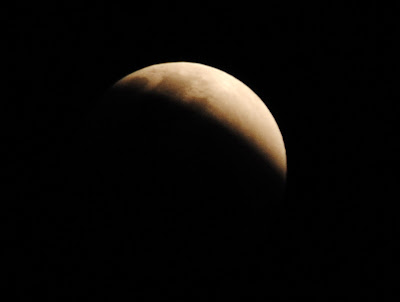Yesterday evening was one of the rare moments where you can see a total eclipse during a decent timing and with a clear night sky! Below are five photos that I've took from my home.
Going...
Gone? Not exactly.... during total eclipse, the moon gives off a reddish hue.
A total lunar eclipse occurs only during a full moon when the Earth's satellite slips into our planet's shadow. It does not turn totally dark, thanks to indirect sunlight which gives it the red colour.
Read here to see a more detailed explanation of why the moon looks red during a total eclipse.

I like this photo with the stars at the surrounding of the red moon during total eclipse!A total lunar eclipse occurs only during a full moon when the Earth's satellite slips into our planet's shadow. It does not turn totally dark, thanks to indirect sunlight which gives it the red colour.
Read here to see a more detailed explanation of why the moon looks red during a total eclipse.

And soon, the moon was no longer completely covered by the shadow.... as it slowly regains its usual look.
7.31 pm - Start of Penumbra Eclipse.
8.45 pm - Start of Umbra Partial Phase.
10.05 pm - Start of Total Eclipse.
10.31 pm - Maximum Eclipse.
10.57 pm - End of Total Eclipse.
12.18 am - End of Umbra Partial Eclipse.
1.31 am - End of Penumbra Eclipse.
7.31 pm - Start of Penumbra Eclipse.
8.45 pm - Start of Umbra Partial Phase.
10.05 pm - Start of Total Eclipse.
10.31 pm - Maximum Eclipse.
10.57 pm - End of Total Eclipse.
12.18 am - End of Umbra Partial Eclipse.
1.31 am - End of Penumbra Eclipse.









No comments:
Post a Comment